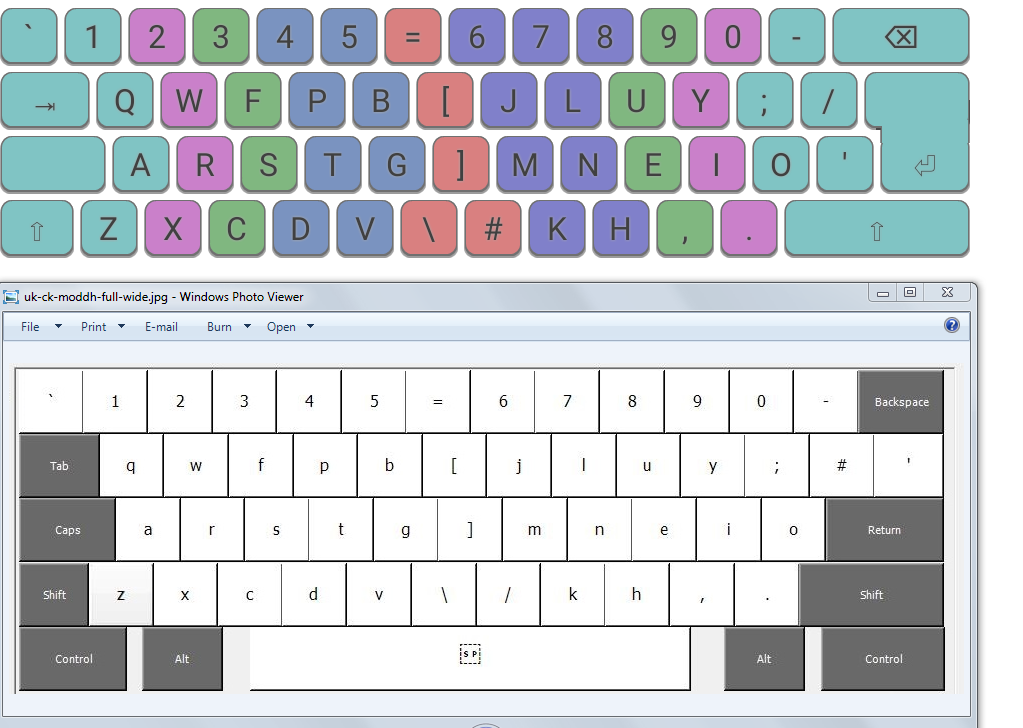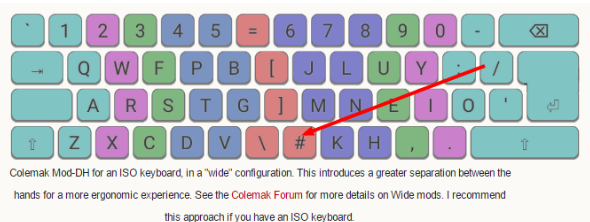Two and a half years in now! And I think, time to reassess? Thinking time, again. ;-)
I'm unhappy that we have two competing DH-mods. Makes implementations a hassle and confuses newcomers. But of course, there are multiple preferences and considerations and it's hard to strike the compromises that make everybody happy enough.
q w F P B J L U Y ;
a R S T g K N E I O The Colemak-Curl(DbgHk) layout – my current Curl-DH mod
z x c v D _ H m
q w F P B J L U Y ;
a R S T g M N E I O The Colemak-Curl(DvbgHm) layout – SteveP's current DH-mod
z x c D v _ K H
Could we do it? See this post.
My proposal is this "best of both worlds, accepting just a little pain" solution:
q w F P B J L U Y ;
a R S T g K N E I O The Colemak-Curl(DvbgHmk) layout
z x c D v _ M H
q w F P B J L U Y ;
a R S T g K N E I O The Colemak-Curl(DvbgHmk) ANSI-Z layout
x c D v Z M H
It's influenced by the insight that to newcomers the Angle mod doesn't necessarily feel as an automatic single change. In the topic mentioned above, people chimed in that keeping the V in its old QWERTY/Colemak place seems at least as simple as moving ZXCV together. I've thought of it differently because I did the Angle shift first.
In fact, using the above Curl-DH mod with the AngleWide mod as I'd do (I call it Colemak-CAW), both V and M would remain in their old unmodded positions! That's kind of nice.
The other major point is that the M in my opinion deserves a better position than the "dethroned" middle trench. The above position will be better for it, at least on staggered boards which are by far the most common ones (actually, I don't like pure matrix boards). This means moving one more key compared to my current Curl-DH mod, but you know – so be it. I've come to think that the benefits will be worth this price in the long run.
For the record, Wikipedia (citing R. Lewand) and the Cornell page of letter frequencies in English report these numbers for the letters involved:
D: 4.3%
G: 2.0%
B: 1.5%
V: 1.0% (1.0–1.1%)
H: 6.0% (5.9–6.1%)
M: 2.5% (2.4–2.6%)
K: 0.7% (0.7–0.8%)
These frequencies, of course, tell nothing about the efficiency of n-grams. We've all noticed how much nicer the important HE bigram becomes with both the current DH-mods.
Heh, judging from pure letter frequencies the V might have to move to the upper row! But that'd bork the Ctrl+V shortcut way too much. So no. Just no. Right...?
I've come to realize that what the left-hand issue amounts to is not as much two different DH-mods as two different Angle mods! I may end up providing one Angle mod moving V and one not moving it, for ISO boards. For ANSI boards it wouldn't make much sense to insert Z between C and V per se, but for ISO boards inserting B there would make sense from a pure letter frequency point of view. Doing it that way would add a modularity that'd let people choose freely between the current left-hand DH mods without having more than one main DH mod. There are already several Angle mods and that's the way it has to be I think, so the hit there wouldn't be too bad. I have to think about that one!
Benefits, comparing the above proposal to the current DbgHk (mine) and DvbgHm (SteveP's) mods:
+ One common DH-mod would be much easier to promote and implement! Curlers, unite! :-þ
+ Apparently, slightly better D and H positions than DbgHk's – according to many users' preferences
+ Better M position than DvbgHm's position, at least on normal-staggered boards
+ Even B is actually somewhat more common than V in English, so V shouldn't have a prime position
+ [Edit 2017-09:] V and M (and K as well) are kept on their native rows, and with the Wide mod even in their native positions!
Pains:
- Three keys are moved on the right hand, two more than standard Colemak, one more than DbgHk
- The XCV Cut/Copy/Paste block is split up, unlike DbgHk
- This makes Extend a little uglier, wedging the left mouse button between Copy and Paste
Last edited by DreymaR (18-Sep-2017 15:31:16)

